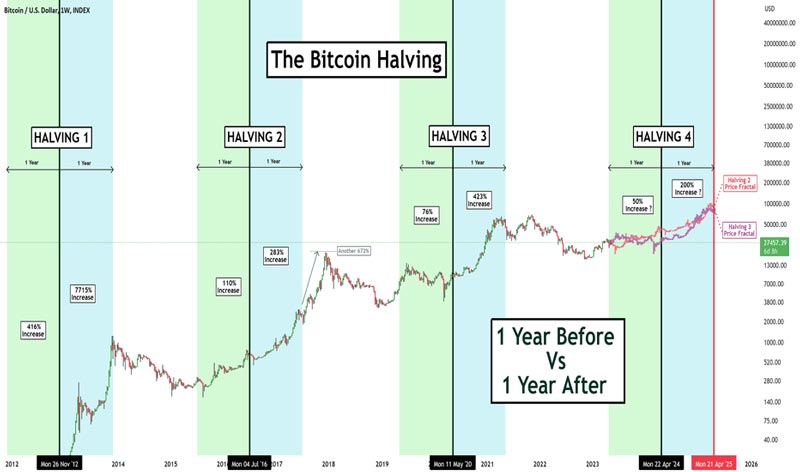What you are about to read:
The Bitcoin Halving is a predetermined event that occurs approximately every four years. It’s a significant part of the overall design of cryptocurrency and affects the rate of production and supply of new coins in circulation. To provide a comprehensive overview, let’s delve into the details of this event, its purpose, and its implications for the Bitcoin ecosystem in this article from Brokerland.
What is Bitcoin Halving?
The Bitcoin Halving mechanism is unique and distinguishes it from traditional currencies. While most fiat currencies have a monetary policy accompanied by inflation, where central banks can increase the money supply, the supply of Bitcoin is controlled by mathematical rules and is programmed to decrease over time.
Bitcoin, like many other cryptocurrencies, relies on a decentralized network of nodes for validation and processing of transactions. One crucial aspect of this system is the issuance of new coins, which rewards miners for Bitcoin mining and maintaining the network.
Miners use powerful computers to solve complex mathematical puzzles, known as hash algorithms, which confirm and add transactions to the blockchain. In return for their efforts, newly created bitcoins are awarded to them. This process, known as “mining,” serves as a mechanism for distributing new coins while also securing the network.
However, the Bitcoin Halving protocol is designed to limit the total supply of BTC to 21 million. To ensure a gradual approach to this limit and to incentivize miners to continue supporting the network as the supply approaches its maximum threshold, the Bitcoin protocol includes the mechanism.
How Does Halving Occur?
The Bitcoin Halving event involves a reduction in the reward granted to miners for adding new blocks to the blockchain. This reward reduction occurs approximately every 210,000 blocks, or roughly once every four years. When Bitcoin was first launched in 2009, the block reward was set at 50 BTC per block. After the first halving in 2012, the reward decreased to 25 BTC. Then, after the second time in 2016, it reduced to 12.5 bitcoins. The third one, which occurred in May 2020, further reduced the reward to 6.25 bitcoins per block.
Impact of Bitcoin Halving
The impacts of halving are significant and are unique to Bitcoin, unlike in most other currencies such as Ethereum and meme coins.
Supply Reduction: The most immediate effect of Bitcoin halving is the reduction in the number of newly introduced bitcoins into circulation. This decrease in the rate of new supply negatively impacts the value of the currency and theoretically makes existing coins more valuable.
Miners’ Economics: With the halving of block rewards, miners’ income from newly minted coins decreases. This could potentially lead to lower profit margins for miners, especially those using older and less efficient hardware.
However, the protocol’s difficulty adjustment mechanism ensures that blocks continue to be mined at a predictable rate of one block every 10 minutes, and solving cryptographic puzzles becomes more challenging with the overall network hash rate. This adjustment helps maintain a competitive market for miners despite halving.
Market Sentiment: This event is closely watched by investors, traders, and enthusiasts, often sparking speculation and significant discussions. Predictions of supply reduction and potential increases in value can lead to price hikes before and after Bitcoin halving. However, it’s essential to remember that the market is influenced by many other factors, and past performance is not indicative of future results.
Network Security: One of BTC’s key features is its decentralized nature, relying on a network of independent miners to maintain the integrity of the blockchain. The Bitcoin halving event ensures that miners continue to receive rewards for their efforts, and with the reduction in new coin supply, the network’s security is maintained.
Why does this mechanism matter and happen?
Bitcoin halving is a significant event in the ecosystem that occurs approximately every four years. Understanding its importance requires understanding how BTC works.
Bitcoin operates on a decentralized ledger system called the blockchain. This technology enables safe and transparent recording and validation of transactions without the need for intermediaries like banks. The blockchain is maintained by a network of computers known as nodes, which work together to confirm and record new transactions.
A key feature of the network is its fixed supply. There will only ever be 21 million BTC, making it a deflationary asset. This scarcity is a key factor in its value, making activities like cloud mining or mining popular.
The creation of new bitcoins, or “mining,” is how bitcoins enter circulation. Miners use powerful computers to solve complex mathematical puzzles that confirm and record transactions on the blockchain. In return for their efforts, miners receive rewards in the form of new coins.
This reward is what is halved during a halving event. Approximately every four years or every 210,000 blocks, the number of bitcoins awarded to miners for solving a block is halved. This event is known as halving. But why does this happen?
- Scarcity: Bitcoin halving is a deliberate mechanism designed to control the supply of bitcoins. By this mechanism the reward every four years, the rate of new coin creation decreases over time, making it scarcer.
- Inflation control: Bitcoin’s monetary policy aims to reduce inflation, meaning the supply of bitcoins decreases over time. Halving helps manage the rate of new coin creation and prevents rapid inflation.
- Network security: The reward for mining new bitcoins incentivizes miners to maintain the network’s security. With reduced rewards over time, halving ensures that only the most efficient and dedicated miners continue to participate in the network.
- Decentralization: By reducing the mining reward, it ensures that the network remains decentralized. With lower rewards, miners are less likely to concentrate their operations in areas with cheap electricity or where mining is subsidized.
Overall, halving is an important event that helps ensure the long-term stability and security of the Bitcoin network. It’s a key factor in Bitcoin’s deflationary nature, and investors and enthusiasts closely monitor it.
Summary
Bitcoin halving, as discussed in this article to learn forex, is a significant event that occurs approximately every four years, resulting in a reduction in the block reward given to miners. This mechanism helps regulate the entry rate of new coins into circulation and ensures that the supply of cryptocurrency gradually reaches its maximum of 21 million coins.
It has a wide range of consequences, from its impact on miners and network security to its effect on market sentiment and Bitcoin’s price. Understanding this event is crucial for anyone interested in the ecosystem and its underlying principles.
Historically, halving events have been accompanied by a significant increase in the price of BTC. This is partly due to the decrease in the supply of new coins entering the market and the increased interest from investors in this asset. However, it’s important to note that past performance is not indicative of future results, and the price of BTC can be highly volatile.










